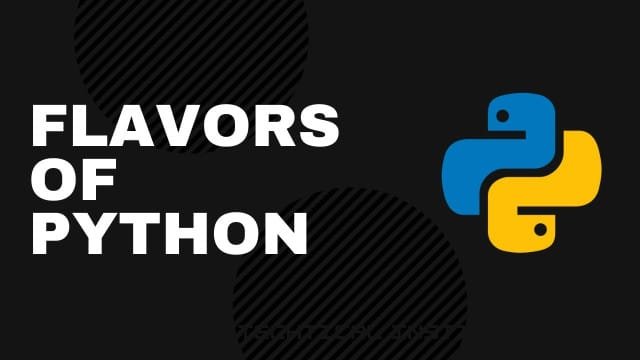Flavors of Python
In this tutorial, we are going to discuss about the Flavors of Python programming language. Python has several “flavors” or implementations, each designed to fulfill specific needs or to enhance compatibility with different environments.

Here’s an overview of the most notable Python flavors:
1. CPython
- Description: The reference implementation of Python, written in C.
- Use Cases: General-purpose programming, most widely used implementation.
- Advantages:
- Broadest library support.
- Extensive community and documentation.
- Direct access to C libraries.
- Disadvantages:
- Slower execution speed compared to some other languages.
- Global Interpreter Lock (GIL) can limit multi-threading performance.
2. PyPy
- Description: A fast, compliant alternative to CPython, using Just-In-Time (JIT) compilation.
- Use Cases: Performance-critical applications where execution speed is paramount.
- Advantages:
- Significant speed improvements for many programs.
- Can lead to reduced memory usage for certain workloads.
- Disadvantages:
- Compatibility issues with some CPython extensions.
- Slightly less extensive library support compared to CPython.
3. Jython
- Description: An implementation of Python designed to run on the Java platform.
- Use Cases: Integration with Java applications, leveraging Java libraries.
- Advantages:
- Seamless integration with Java.
- Can use Java libraries directly.
- Enables scripting in Java applications.
- Disadvantages:
- Typically slower than CPython.
- Some Python libraries dependent on C extensions may not work.
4. IronPython
- Description: An implementation of Python for the .NET framework.
- Use Cases: Integration with .NET applications, leveraging .NET libraries.
- Advantages:
- Seamless integration with .NET.
- Can use .NET libraries directly.
- Enables scripting in .NET applications.
- Disadvantages:
- Typically slower than CPython.
- Some Python libraries dependent on C extensions may not work.
5. MicroPython
- Description: A lean and efficient implementation of Python for microcontrollers and constrained environments.
- Use Cases: Embedded systems, IoT devices.
- Advantages:
- Small memory footprint.
- Designed for microcontrollers.
- Real-time operating system (RTOS) support.
- Disadvantages:
- Limited subset of the Python standard library.
- Less extensive library support compared to CPython.
6. CircuitPython
- Description: A derivative of MicroPython aimed at beginners and education, developed by Adafruit.
- Use Cases: Educational purposes, beginner projects on microcontrollers.
- Advantages:
- User-friendly.
- Extensive documentation and community support.
- Designed to work seamlessly with Adafruit hardware.
- Disadvantages:
- Limited to supported hardware.
- Less comprehensive than full Python implementations.
7. Stackless Python
- Description: An enhanced version of CPython, designed to provide micro-threads for massive concurrency.
- Use Cases: Applications requiring high concurrency, like games or real-time simulations.
- Advantages:
- Lightweight micro-threads.
- Efficient task management.
- Disadvantages:
- Limited adoption.
- Potential compatibility issues with certain libraries.
8. Anaconda
- Description: A distribution of Python and R for scientific computing and data science.
- Use Cases: Data science, machine learning, scientific research.
- Advantages:
- Comes with a wide array of pre-installed libraries (e.g., NumPy, Pandas, SciPy).
- Includes tools like Jupyter Notebook and Conda package manager.
- Simplifies package management and deployment.
- Disadvantages:
- Larger download size.
- Potentially redundant for users not needing the bundled tools.
9. ActivePython
- Description: A commercially supported distribution of Python by ActiveState.
- Use Cases: Enterprise environments requiring commercial support and pre-compiled packages.
- Advantages:
- Commercial support.
- Pre-compiled packages.
- Enhanced security and compliance features.
- Disadvantages:
- Cost associated with commercial support.
- Less community-driven compared to open-source distributions.
10. Brython
- Description: An implementation of Python that runs in the browser, translating Python to JavaScript.
- Use Cases: Client-side web development, educational tools.
- Advantages:
- Enables Python to run in the browser.
- Can interact with the DOM.
- Disadvantages:
- Performance constraints compared to JavaScript.
- Limited to browser environments.
Summary
Python’s versatility is reflected in its various implementations, each tailored to different use cases and environments. Whether you need high performance (PyPy), integration with Java or .NET (Jython, IronPython), support for embedded systems (MicroPython, CircuitPython), or scientific computing tools (Anaconda), there’s likely a Python flavor that suits your needs. Understanding the strengths and limitations of each can help you choose the right implementation for your specific project.
That’s all about the Flavors of Python programming language. If you have any queries or feedback, please write us email at contact@waytoeasylearn.com. Enjoy learning, Enjoy Python language.!!